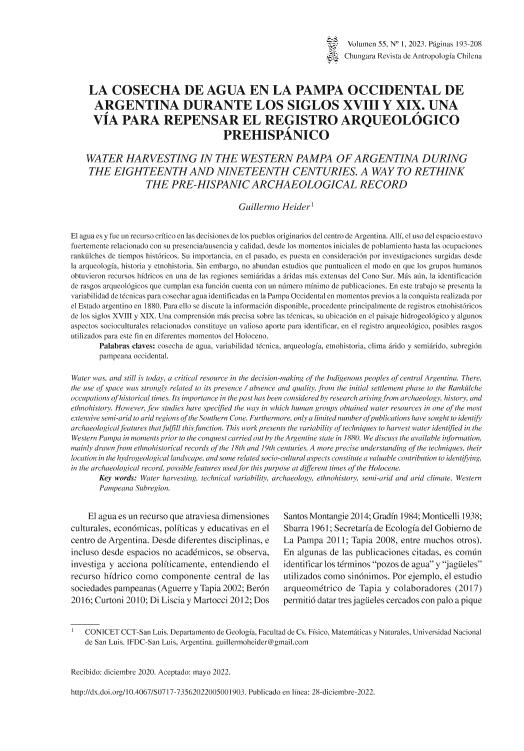Mostrar el registro sencillo del ítem
dc.contributor.author
Heider, Guillermo

dc.date.available
2023-12-06T16:02:15Z
dc.date.issued
2023-01
dc.identifier.citation
Heider, Guillermo; La cosecha de agua en la Pampa Occidental de Argentina durante los siglos XVIII y XIX: una vía para repensar el registro arqueológico prehispánico; Universidad de Tarapacá. Facultad de Ciencias Sociales y Jurídicas. Departamento de Antropología; Chungará; 55; 1; 1-2023; 193-208
dc.identifier.issn
0716-1182
dc.identifier.uri
http://hdl.handle.net/11336/219531
dc.description.abstract
El agua es y fue un recurso crítico en las decisiones de los pueblos originarios del centro de Argentina. Allí, el uso del espacio estuvo fuertemente relacionado con su presencia/ausencia y calidad, desde los momentos iniciales de poblamiento hasta las ocupaciones rankülches de tiempos históricos. Su importancia, en el pasado, es puesta en consideración por investigaciones surgidas desde la arqueología, historia y etnohistoria. Sin embargo, no abundan estudios que puntualicen el modo en que los grupos humanos obtuvieron recursos hídricos en una de las regiones semiáridas a áridas más extensas del Cono Sur. Más aún, la identificación de rasgos arqueológicos que cumplan esa función cuenta con un número mínimo de publicaciones. En este trabajo se presenta la variabilidad de técnicas para cosechar agua identificadas en la Pampa Occidental en momentos previos a la conquista realizada por el Estado argentino en 1880. Para ello se discute la información disponible, procedente principalmente de registros etnohistóricos de los siglos XVIII y XIX. Una comprensión más precisa sobre las técnicas, su ubicación en el paisaje hidrogeológico y algunos aspectos socioculturales relacionados constituye un valioso aporte para identificar, en el registro arqueológico, posibles rasgos utilizados para este fin en diferentes momentos del Holoceno.
dc.description.abstract
Water was, and still is today, a critical resource in the decision-making of the Indigenous peoples of central Argentina. There, the use of space was strongly related to its presence / absence and quality, from the initial settlement phase to the Rankülche occupations of historical times. Its importance in the past has been considered by research arising from archaeology, history, and ethnohistory. However, few studies have specified the way in which human groups obtained water resources in one of the most extensive semi-arid to arid regions of the Southern Cone. Furthermore, only a limited number of publications have sought to identify archaeological features that fulfill this function. This work presents the variability of techniques to harvest water identified in the Western Pampa in moments prior to the conquest carried out by the Argentine state in 1880. We discuss the available information, mainly drawn from ethnohistorical records of the 18th and 19th centuries. A more precise understanding of the techniques, their location in the hydrogeological landscape, and some related socio-cultural aspects constitute a valuable contribution to identifying, in the archaeological record, possible features used for this purpose at different times of the Holocene.
dc.format
application/pdf
dc.language.iso
spa
dc.publisher
Universidad de Tarapacá. Facultad de Ciencias Sociales y Jurídicas. Departamento de Antropología
dc.rights
info:eu-repo/semantics/openAccess
dc.rights.uri
https://creativecommons.org/licenses/by-nc/2.5/ar/
dc.subject
COSECHA DE AGUA
dc.subject
VARIAVILIDAD TÉCNICA
dc.subject
ARQUEOLOGÍA
dc.subject
ETNOHISTÓRIA
dc.subject
CLIMA ÁRIDO Y SEMIÁRIDO
dc.subject
SUB-REGIÓN PAMPA OCCIDENTAL
dc.subject.classification
Arqueología

dc.subject.classification
Historia y Arqueología

dc.subject.classification
HUMANIDADES

dc.title
La cosecha de agua en la Pampa Occidental de Argentina durante los siglos XVIII y XIX: una vía para repensar el registro arqueológico prehispánico
dc.title
Water harvesting in the western pampa of argentina during the eighteenth and nineteenth centuries: a way to rethink the pre-hispanic archaeological record
dc.type
info:eu-repo/semantics/article
dc.type
info:ar-repo/semantics/artículo
dc.type
info:eu-repo/semantics/publishedVersion
dc.date.updated
2023-12-05T15:02:49Z
dc.identifier.eissn
0717-7356
dc.journal.volume
55
dc.journal.number
1
dc.journal.pagination
193-208
dc.journal.pais
Chile

dc.journal.ciudad
San Miguel de Azapa
dc.description.fil
Fil: Heider, Guillermo. Consejo Nacional de Investigaciones Científicas y Técnicas. Centro Científico Tecnológico Conicet - San Luis; Argentina. Universidad Nacional de San Luis. Facultad de Ciencias Físico Matemáticas y Naturales. Departamento de Geología; Argentina
dc.journal.title
Chungará
dc.relation.alternativeid
info:eu-repo/semantics/altIdentifier/url/https://www.scielo.cl/scielo.php?script=sci_arttext&pid=S0717-73562023000100193
Archivos asociados
